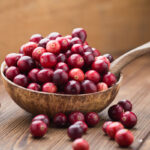The Cranberry Institute's new digital resource shows health benefits of cranberry consumption

The Cranberry Institute has launched its latest digital resource, The Berry Best Guidebook, which compiles all the research behind the health benefits of cranberries. While decades of research support the role of cranberries in health, new studies continue to uncover even more potential benefits.
The online resource makes it easy to explore the bioactive compounds in the fruit and their proven effects. The guide includes links to help access each section including stomach – suppression of H. pylori, gut microbiome, urinary tract health, support of nerve cells and cognition, and others.
While most cranberries are harvested between September and October in the U.S., all forms of cranberry (juice, fresh, sauce, or dried berries) are healthy and can be enjoyed year-round.
The fruit is rich in healthful bioactive compounds including polyphenols such as proanthocyanidins (PACs), anthocyanins, and flavonoids, and are one of the only foods rich in A-type PACs which give cranberries the ability to inhibit bacterial adhesion in the body.
Cranberry anthocyanins have been shown to be the most highly available to the body.
Cranberry polyphenols help prevent biofilm formation, which benefits the body by keeping bad bacteria at bay. Biofilm is a layer of bacteria that grows and sticks to a surface, this can happen during the early stages of the development of an infection in the body.
An evaluation of food data collected from more than 3800 people through the National Health and Nutrition Examination Survey from 2005 to 2010 was used to develop a dietary index for healthy gut microbiota.
The research identified cranberries as part of a short list of foods found to benefit gut microbiota diversity and production of short-chain fatty acids (SCFAs), a metabolite produced by the fermentation of fiber by the gut microbiome. A growing body of research supports the role of SCFAs in fighting inflammation and supporting immunity.
Other benefits of the fruit include supporting oral health, cardiometabolic health, and cardiovascular support.









































